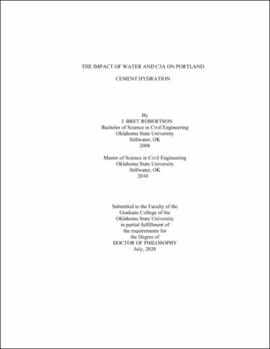| dc.contributor.advisor | Ley, M. Tyler | |
| dc.contributor.author | Robertson, J. Bret | |
| dc.date.accessioned | 2021-02-22T22:24:14Z | |
| dc.date.available | 2021-02-22T22:24:14Z | |
| dc.date.issued | 2020-07 | |
| dc.identifier.uri | https://hdl.handle.net/11244/328625 | |
| dc.description.abstract | The water-cement ratio (w/cm) is one of the most influential parameters to determine the quality of concrete. A new test method, the Phoenix, has been developed that uses external heat to evaporate the water from the concrete before it has hardened. The method, calculation, and practical applications of this new test method are presented. This work also compares how the w/cm impacts fresh and hardened property measurements from slump, unit weight, surface resistivity, compressive strength, and the Phoenix. This work shows the accuracy of each measurement technique to determine changes in w/cm in field concrete. This work will aim to investigate how long a sample can be tested after mixing and obtain an accurate result and how long a sample can remain in the kiln before the materials decompose and change the results. These are important questions that limit the timing in the test method. Over 400 mixtures in the laboratory and field were conducted to validate the Phoenix and develop practical applications. In addition to a new test method, Tricalcium aluminate (C3A) particles were also evaluated using X-ray nano-computed tomography (nCT) and nano X-ray fluorescence (nXRF). When these are combined, a technique named nano-tomography assisted chemical correlation (nTACCo) will be utilized to investigate three C3A particles. C3A plays a major role in the early hydration of Portland cement. Insights into C3A dissolution and hydration product formation are important steps in understanding Portland cement hydration. The microstructural and chemical composition changes are directly observed, quantified, and discussed. | |
| dc.format | application/pdf | |
| dc.language | en_US | |
| dc.rights | Copyright is held by the author who has granted the Oklahoma State University Library the non-exclusive right to share this material in its institutional repository. Contact Digital Library Services at lib-dls@okstate.edu or 405-744-9161 for the permission policy on the use, reproduction or distribution of this material. | |
| dc.title | Impact of water and C3A on Portland cement hydration | |
| dc.contributor.committeeMember | Cross, Stephen | |
| dc.contributor.committeeMember | Russell, Bruce | |
| dc.contributor.committeeMember | Materer, Nicholas | |
| osu.filename | Robertson_okstate_0664D_16831.pdf | |
| osu.accesstype | Open Access | |
| dc.type.genre | Dissertation | |
| dc.type.material | Text | |
| dc.subject.keywords | c3a hydration | |
| dc.subject.keywords | ntacco | |
| dc.subject.keywords | phoenix | |
| dc.subject.keywords | tricalcium aluminate hydration | |
| dc.subject.keywords | w/cm test | |
| dc.subject.keywords | water to cement ratio test | |
| thesis.degree.discipline | Civil Engineering | |
| thesis.degree.grantor | Oklahoma State University | |
